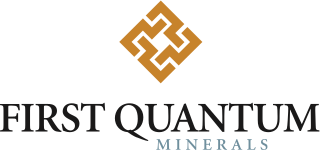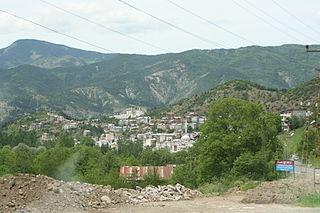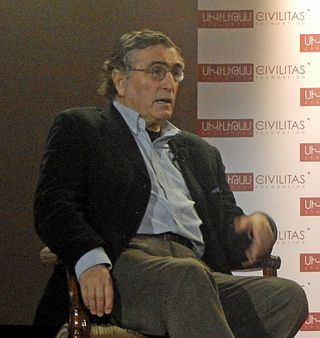Related Research Articles

First Quantum Minerals is a Canadian-based mining and metals company whose principal activities include mineral exploration, development and mining. Its main product is copper, which accounts for 80% of revenues as of 2016.

Şavşat is a town in Artvin Province in the Black Sea region, between the cities of Artvin and Kars on the border with Georgia at the far eastern end of Turkey. It is the seat of Şavşat District. Its population is 6,048 (2021).

Murgul is a town in Artvin Province in the Black Sea region of Turkey. It is the seat of Murgul District. Its population is 5,020 (2021).

The Yusufeli Dam is an arch dam on the Çoruh River near Yusufeli in Artvin Province within the eastern Black Sea region of Turkey. The Yusufeli Dam will be the second largest dam within the larger Çoruh River Development Plan, which plans to build 13 dams, of which two are operational and another two are under construction. The dam's main purpose is hydroelectric power production and it will support a 540 MW power station. The dam is controversial because of its projected impact on the biodiversity within its reservoir area along with the relocation of the locals.
The Çakmakkaya mine is a large mine in the east of Turkey in Artvin Province 465 km east of the capital, Ankara. Çakmakkaya represents one of the largest copper reserve in Turkey having estimated reserves of 100 million tonnes of ore grading 0.8% iron. The 100 million tonnes of ore contains 800,000 tonnes of copper metal.
Damar is a village in the Murgul District, Artvin Province, Turkey. It lies just to the south east of Murgul. The town was once a district center, but in 1950 its status was reduced to a township (belde). At the 2013 reorganisation, it became a village. Damar is a mining town and is one of the main producers of copper in Turkey.
The Artvin Dam an arch-gravity dam on the Çoruh River in Artvin Province, Turkey. Preliminary construction on the dam began in December 2010 and the river diversion tunnels were complete in July 2012 at which time construction on the dam foundation started. The purpose of the dam is hydroelectric power generation and its power station has an installed capacity of 340 MW when completed. The dam is part of the Çoruh Development Plan and its construction was supervised by Turkey's State Hydraulic Works. The dam began to impound its reservoir in October 2015 and the power station was commissioned beginning in January 2016.

Hasan Cemal is a Turkish journalist and writer. He was the editor of Cumhuriyet from 1981 to 1992, and of Sabah from 1992 to 1998. In 2013 he resigned from the Milliyet newspaper after Prime Minister Recep Tayyip Erdoğan had criticised his article supporting Milliyet's publication of minutes of a parliamentary visit to Abdullah Öcalan, and Milliyet suspended him and refused to publish his returning column.
Ethem Sarısülük was an activist and worker who was killed by the police in Ankara during the 2013 Gezi Park protests. Sarısülük, who was seriously injured by police officer Ahmet Şahbaz during the Gezi Park protests in Ankara, stayed in intensive care unit for 14 days. He was diagnosed with brain death on 12 June 2013 and died in Ankara Numune Hospital on 14 June 2013 at 3:15 pm. In the autopsy report it was stated that the bullet which killed him was found inside the brain.
The Çöpler mine is a gold mine located in Erzincan Province, eastern Turkey. It is owned and operated by the Anagold Mining Inc., established in 2009. Explored in 1999, it is on an epithermal gold-silver-copper ore deposit, one of the largest in Turkey and in the world. The Çöpler mine started production in 2010.

On 13 May 2014, blasting at Eynez coal mine in Soma, Manisa, Turkey, caused an underground mine fire, which burned until 15 May. In total, 301 people were killed, making it the worst mine disaster in Turkey's history. The mine, operated by coal producer Soma Kömür İşletmeleri A.Ş., suffered a fire, the causes of which were later found to be complex. The fire occurred at the mine's shift change, when 787 workers were underground. At the time, the disaster was thought to be mainly an explosion rather than fire. After the last bodies were pulled from the mine on 17 May 2014, four days after the fire, the Minister of Energy and Natural Resources Taner Yıldız confirmed the number of dead was 301. Disaster and Emergency Management Presidency (AFAD) announced the names of the 301 workers who died in the mine disaster and the 486 miners who survived.

Özgecan Aslan was a Turkish university student who was murdered while resisting attempted rape on 11 February 2015 on a minibus in Mersin, Turkey. Her burnt body was discovered on 13 February. The murder was committed by minibus driver Ahmet Suphi Altındöken, and his father Necmettin Altındöken and friend Fatih Gökçe were accomplices in covering up the murder. All perpetrators were handed aggravated life sentences without the possibility of parole.

On 19 March 2016, a suicide bombing took place in Istanbul's Beyoğlu district in front of the district governor's office. The attack occurred at 10:55 (EET) at the intersection of Balo Street with İstiklal Avenue, a central shopping street. The attack caused at least five deaths, including that of the perpetrator. Thirty-six people were injured, including seven whose injuries were severe. Among those injured were twelve foreign tourists. Among those killed, three were of Israeli nationality. On 22 March, the Turkish interior minister said that the bomber had links with ISIL.

Rize–Artvin Airport is an airport off the coast of in Rize Province, northeastern Turkey.
Kadri Gürsel is a Turkish journalist. He became prominent when the Turkish government imprisoned him for his coverage on groups associated with terrorism. On October 31, 2016, while working for the newspaper Cumhuriyet, Kadri Gürsel was taken into custody together with many of his colleagues. The journalists were arrested for alleged ties to terrorist organizations, including the Kurdistan Workers' Party (PKK), the Revolutionary People's Liberation Party-Front (DHKP-C), and the Fethullahist Terrorist Organization (FETÖ).

Coal supplies a quarter of Turkey's primary energy. The heavily subsidised coal industry generates over a third of the country's electricity and emits a third of Turkey's greenhouse gases.
Çöpler is a village in the İliç District of Erzincan Province in Turkey. The village is populated by Kurds of the Şikakî tribe and had a population of 289 in 2022.
Guleman mine is a chromium mine in Alacakaya (Guleman), Elazığ, Turkey. The mine started to operation in 1936 by Etibank.
On 13 February 2024, at the Çöpler Gold Mine in Erzincan Province, eastern Turkey, a mass of heap leach material collapsed, trapping a group of nine miners as it slid toward a creek.
References
- ↑ "20 yıldır direnen Cerattepe'den davet var". NTV. 27 October 2007. Archived from the original on 28 February 2016. Retrieved 21 February 2016.
- 1 2 3 4 5 "Habertürk Cerattepe dosyasını açıyor". Habertürk. 12 July 2015. Retrieved 21 February 2016.
- 1 2 3 4 5 6 7 8 "TMMOB Cerattepe Raporu" (PDF). Turkish Union of Chambers of Engineers and Architects. Archived from the original (PDF) on 21 February 2016. Retrieved 21 February 2016.
- ↑ "Cerattepe için en büyük doğa davası". Cumhuriyet. 10 July 2015. Retrieved 21 February 2016.
- ↑ Eminağaoğlu, Özgür; Anşin, Rahim (2005). "THE FLORA OF CERATTEPE, MEYDANLAR, DEMİRCİ, GAVUR CREEK AND NEAR ENVIRONMENT IN ARTVİN" (PDF). Review of the Faculty of Forestry, Istanbul University. 55 (2): 31–46. Archived from the original (PDF) on 4 March 2016. Retrieved 21 February 2016.
- ↑ "Artvin İli Maden Yatakları". Maden Tetkik Arama. Archived from the original on 24 April 2016. Retrieved 21 February 2016.
- ↑ "Doğu Karadeniz'in zengin rezervleri değerlendirilemiyor". Milliyet. 23 February 2012. Retrieved 21 February 2016.
- ↑ Kas, Nilüfer (5 July 1995). "Yeşil mi altın mı?". Milliyet.
- ↑ Aydın, Hakan (5 December 2007). ""Doğaya hastayım, maden çıkarsa yastayım"". Milliyet.
- ↑ "Artvin Valiliği Kanadalı şirkete çevreci!". BirGün. 21 February 2016. Retrieved 21 February 2016.
- 1 2 "Cerattepe'de çevreciler harekete geçti". Sözcü. Retrieved 21 February 2016.
- 1 2 "Cerattepe için direnenlere polis saldırısı". Cumhuriyet. Retrieved 21 February 2016.
- ↑ "Artvin Cerattepe'de dün gece de maden karşıtı eylem vardı". Hürriyet. Retrieved 21 February 2016.
- ↑ "Artvin'de boğalar 'Cerattepe' için sokağa indi". Zaman. Archived from the original on 21 February 2016. Retrieved 21 February 2016.
- ↑ "Artvin'e tüm giriş çıkışlar yasaklandı!". Taraf. Archived from the original on 23 February 2016. Retrieved 28 February 2016.
- ↑ "Artvin'e tüm giriş çıkışlar yasaklandı! ("All entry to and exit from Artvin has been banned!")". CNN Türk. Retrieved 28 February 2016.
- 1 2 "Artvin Cerattepe'de gergin bekleyiş sürüyor". Hürriyet. Retrieved 21 February 2016.
- ↑ "Artvin Valiliği'nden "Vurun geçin" sözlerine yalanlama". Sabah. Retrieved 21 February 2016.
- ↑ "Cerattepe'deki madencilik faaliyetleri durduruldu". NTV. Retrieved 28 February 2016.
- ↑ "En büyük korku: Cerattepe Murgul olmasın". Radikal. Retrieved 28 February 2016.
- 1 2 "Artvin Cerattepe hakkında 10 soruda çarpıcı gerçekler". Sabah. Retrieved 21 February 2016.
- ↑ "Eti Bakır: Proje çevre tahribatına yol açmayacaktır". Sabah. Retrieved 21 February 2016.
- ↑ Tüfekçioğlu, Aydın; Tilki, Fahrettin; Küçük, Mehmet (2010). "Artvin ili barajlar ve madencilik faaliyetlerinin çevre üzerine etkilerinin ekolojik açıdan değerlendirilmesi Archived March 4, 2016, at the Wayback Machine ", Artvin Çoruh University.